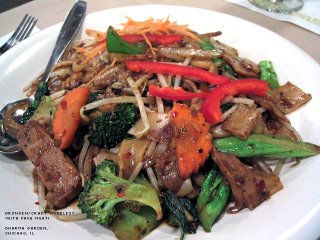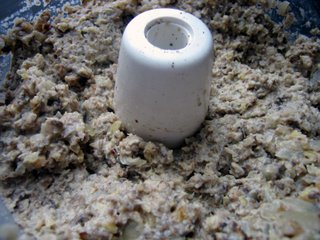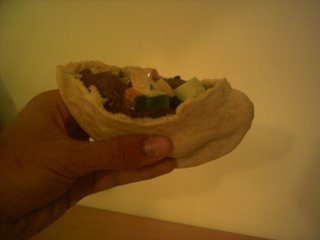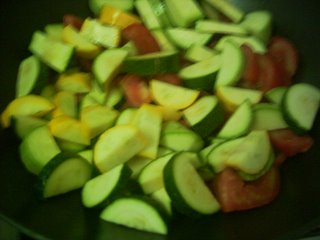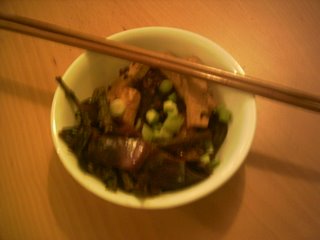My recent post about TVP yielded several emails and conversations about the place of meat substitutes in a vegetarian diet. The comments that most piqued my curiosity were tose of my old-timer vegetarian pals, who questioned the need to eat anything “resembling meat” at all, merely for the sake of how it looks.
They do have a point, there. We all understand the importance of eating enough protein, iron and B12; every responsible vegetarian (well, every responsible person, for that matter) has to take precautions against deficiencies and consume enough protein-rich grains, beans and seeds. As long as this is quality protein, it’s not important what it looks like. Or, as my grandma says sometimes, “it doesn’t stay pretty in your stomach”.
It is, therefore, quite entertaining to see how food industries insist on producing highly-processed, meticulously-designed products which are supposed to be meat substitutes. Tofurkey can be quite funny; it’s made to look like a real turkey. Lightlife produces a series of soy-made salamis and bolognes and turkey slices that look very much like the original (and, if memory serves me right, taste quite like it, too). A short google of “fake meat” or “mock meat” will take you to quite a bunch of links, including restaurant links, which sport realistic-looking “meat” recipes for vegetarians, such as this picture.
This stuff was most likely made from TVP or from seitan, which is textured wheat gluten. Both of these products happen to contain a good amount of good quality protein, but that’s not why they’re there – they’re there to remind vegetarians of meat. The absurd thing is that not all these substitutes have protein, or even are good for you. For example, Tivall, a wildly successful Israeli food manufacturer, produces “wiener schnitzels” made of corn and broccoli. Yes, it has hydrolized vegetable protein (?!?!) and bread crumbs and “flavoring”, but how much actual good protein is in there? Is it just that we need a patty of something on one corner of our plate to feel as if we’ve eaten?
It’s quite obvious – particularly from the Tofurkey example – that the vegetarian search for fake meat is cultural, not nutritional. We miss meat-based dishes of our omnivorous childhood, and want to recreate them in their cruelty-free form. An important corollary follows: it’s not important whether the protein is actually in the fake meat, as long as we get the protein from somewhere. We can therefore have as much Tivall corn schnitzels as we like, we’ll still need beans, and nuts, and perhaps cheese and eggs. This disconnect between how the food looks and what it actually is, is quite disturbing to anyone who wants to eat as close to nature as possible.
But, but but but, let’s not dis our pals who eat these things too soon. For many people who come to vegetarianism, be it for health or conscience reasons, the move is very difficult. This is particularly true for societies in which meat is considered the centerpiece of the meal. Someone who was raised to think of meat as “the meal”, and of rice, and beans, and vegetables, as “those things that come with the meal”, it is very difficult to get used to meals that seem incomplete. Naturally, thinking beyond the traditional plate is to be encouraged; but there is nothing wrong with a little bit of nostalgia, particularly if you can indulge yourself in a healthy, fun way, and not feel deprived.
I don’t miss meat. Really, I don’t. I have no need to eat meat. Haven’t had it for twelve years. There’s one thing in particular I miss, though: my grandma’s chopped liver. It was rich and creamy and nice, and full of fried onions. As I don’t eat chicken innards anymore, I occasionally look for fun vegetarian pates and spreads, and yesterday I made my own in our kitchen. So, here it is, for your eating pleasure.
Vegetarian Chopped Liver
I don’t know exactly what it is, in mock chopped liver recipes, that recreates the alchemy of actual liver. Is it the eggs and the nuts? Is it the aroma of the fried onions? Surely it can’t be the zuccini, because I’ve looked everywhere for recipes, and found recipes that use mushrooms, green beans, and – an Israeli favorite – eggplants. Alas, I had a surplus of zuccini from Chubeza and absolutely had to use it up. I vaguely remembered having eaten something like this in Passover, but could not find the recipe, and my invented one turned out fine. The only problem was that I didn’t add enough salt. We don’t usually add salt, but this recipe is somewhat of an exception, so be generous with the salt shaker.
4-5 large zuccinis or summer squashes
2 large, white onions
1/3 cup good quality olive or canola oil
4 hard-boiled eggs
3/4 cup walnuts
salt and pepper
In a large pan or a wok, heat up the oil. Chop up the onions and fry them until brown. This requires patience: they absolutely must be dark brown for the flavor alchemy to work properly. Once they are nearly there, add up the chopped-up zuccinis. Keep frying, until the zuccini is golden and soft as well, and the onions emit their lovely fried aroma.
Meanwhile, back at the ranch, we need to take care of the eggs and nuts. Simply stick’em in your food processor bowl and grind them to dust.
Add the fried stuff to the food processor bowl, and keep grinding, until you get a brown, uniform paste. Keep tasting it (“oh, no, do we have to?”) and add salt and pepper until your grandmother’s presence is strongly felt in the kitchen. If you come from a different ethnic background and your grandma never makes chopped liver, you can channel mine – hers is fantastic. Anyway: remove from bowl and refrigerate. Enjoy with crackers, vegetables, and – for those of you who eat wheat – fresh bread.


